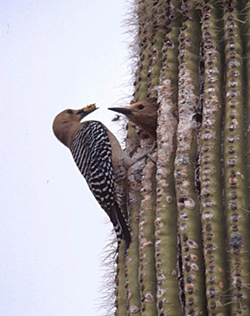
This is a large area, requiring a wide range of diverse plantings. Much of the area is quite dry and calls for drought-resistant plantings. Cover and nesting sites are critical, and should be a major consideration in selecting plants for this region. Flowering shrubs are popular with the many hummingbirds in this area.
On this page
Trees:
Colorado Blue Spruce (Picea pungens) Zones 3 – 5
Slow-growing conifer that grows to 150′. Provides shelter from extreme hot and cold and excellent nesting sites. Seeds, as well as insects under the bark, attract many species and migrants. Perfect for higher elevations with extreme winters.
Rocky Mountain Juniper (Juniperius scopulorium) Zones 4 – 7
Most wide-spread juniper in the west. Slow-growing evergreen to 40′ Produces abundant berries after 2 years that attract many species. Excellent cover.
White Alder (Alnus rhombifolia) Zones 7 – 9
Deciduous; prefers moist soil. Provides food from fall through spring that is attractive to migrants as well as winter residents. Warblers prefer it for roosting, cover, and nesting. Grows quickly in garden settings to 40′ to 100′.
Hawthorne (Cratageus laevigata) Zones 5 – 8
Good choice for urban settings. Grows to 20′ high, and spreads the same. Crimson flowers precede fat, red berries that are favorites of fruit-eating species. Tolerates most conditions except wet soil.
Shrubs:
Golden Currant (Ribes aureum)
Fully frost hardy to zone 2, with abundant fruit attractive to many species. Grows 3′ to 8′ high and makes an excellent hedgerow for cover.
Wolfberry (Lycium species) Zones 6 – 9
Forms 6′ high, dense thickets with spiny branches perfect for cover. Abundant orange-red berries in fall. Thrives in poor, dry soil.
Desert Willow (Chilopsis linearis) Zones 7 – 9
Quick-growing to 6′ to 25′, this prolific bloomer attracts hummingbirds with its trumpet-shaped, purple to pink flowers. Drought-tolerant. Deciduous mid-summer through winter.
Flowering Currant (Ribes sanguineum) Zones 6 – 8
6′ high, deciduous shrub that attracts hummingbirds with its red flowers, and fruit-eating species love its fruit. Likes full sun and fertile soil, and can be pruned into dense hedge.
Mesquite (Prosopis velutina) Zones 4 – 10
Bushy shrub with thorny branches that offer excellent cover and nest sites. Provides seeds for many species and nectar for hummingbirds. Prefers arid, dry soil below 5000′. A good plant for the creatures but not a popular plant for most backyards.
Cacti:
Prickly Pear (Opunita basilaris, O. phaeacantha) Zone 9
Both like sun and free-draining soil, withstand heat and drought, and provide fruits for many species. Good for the animals and the blooms can be beautiful. Not a popular choice for most backyards but is drought resistant.
Vines/Groundcovers:
Wild Strawberry (Fragaria species) Zones 5 – 9
These low-growing plants offer fruits that are eaten by many species of birds and wildlife.
Canyon Grape (Vitis arizonica) Zones 7 – 9
Deciduous vine that produces fruit for many species from summer to fall. Likes sun and moist, well-drained soil.
Aggie Horticulture – Texas A&M University.

